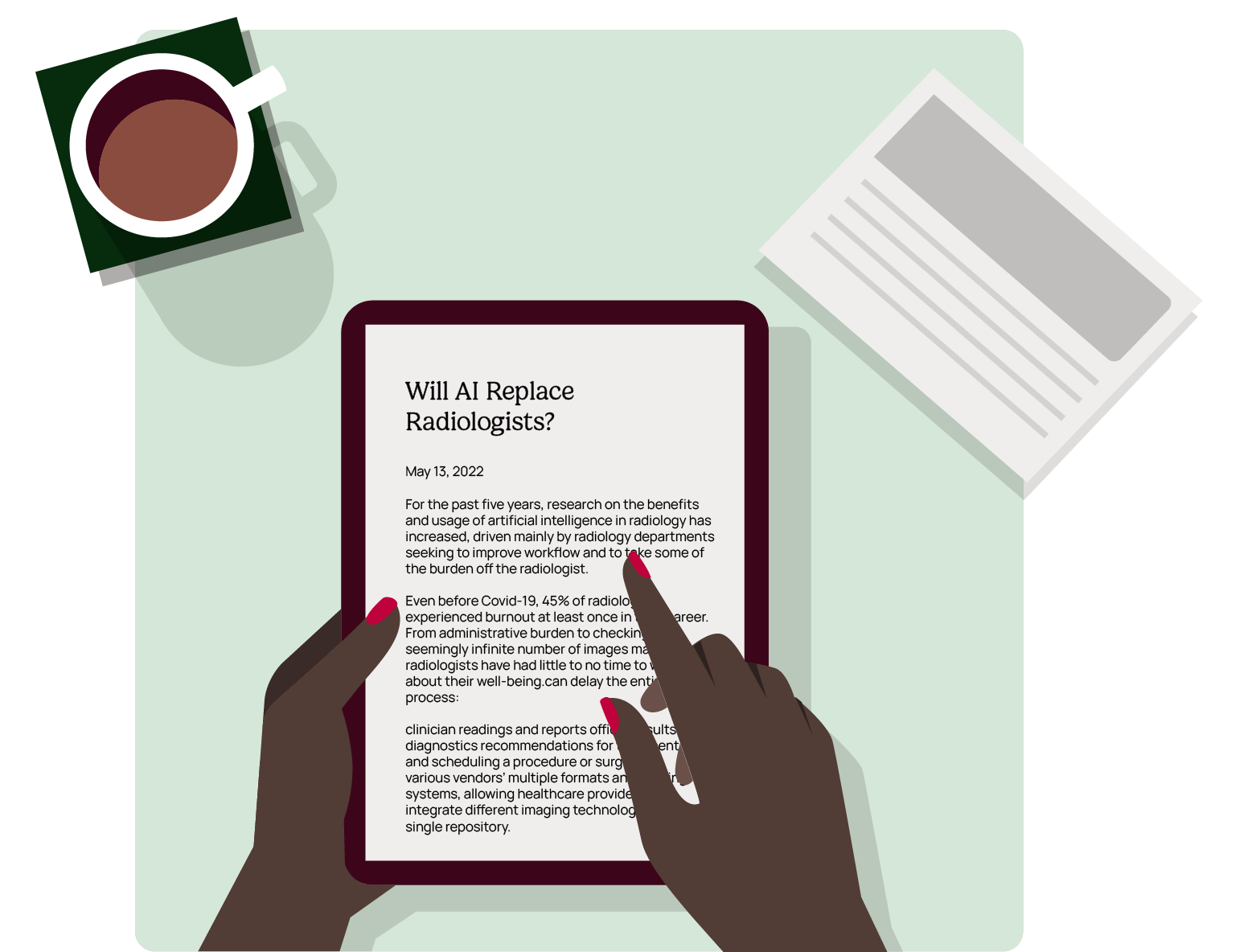May 13, 2022
For the past five years, research on the benefits and usage of artificial intelligence in radiology has increased, driven mainly by radiology departments seeking to improve workflow and to take some of the burden off the radiologist.
Even before Covid-19, 45% of radiologists experienced burnout at least once in their career. From administrative burden to checking a seemingly infinite number of images manually, radiologists have had little to no time to worry about their well-being.
Fortunately, the introduction of AI can help optimize radiologists’ workflow and reduce their workload by assisting in discovering genomic markers, monitoring and registering efficiently and reporting quickly.
Still, rather than embracing the improvements that AI can bring to their work, some experts believe that radiologists focus too much on fears that AI might replace them.
Unfortunately, this leads to skepticism and myths about AI and the future of the field of radiology. Here’s a comprehensive guide to understanding whether AI will replace radiologists or assist them:
A Quick Glance at Whether AI will Replace Radiologists
Industry leaders in radiology are continually looking for ways to optimize workflow through machine learning, deep learning, neural networks, and natural language processing.
Artificial intelligence combined with machine learning promises to offer radiology robust and state-of-the-art digital tools to facilitate radiology processes.
Bib Allen, M.D., FACR, and CMO at the ACR’s DSI believes that AI can significantly increase the value radiology professionals offer patients. Implementing insights identified through the power of AI algorithms to workflow and reporting can improve patient care.
AI cannot replace radiologists. However, it can facilitate everyday tasks performed by radiologists. As a result, early adopters of AI will likely be at the forefront of the radiology field in the future.
The impact of this question has caused concern and shifted the mindset of some radiology medical students. Philip Templeton, Chief Medical Officer, CoFounder at DocPanel Technologies explains, “Unfortunately, this question has steered away medical students from selecting radiology, at a time when there is a great need and shortage of radiologists, as well as a terrific opportunity to work in such a rewarding and exciting field.”
Dan Sperling, M.D., board-certified licensed radiologist, and Medical Director at Sperling Prostate Center adds, “Anxiety over such an outcome has already filtered into medical schools. Sadly, based on such concern many medical students who were considering radiology as their career choice are already rethinking that path, according to a 2021 survey by Reeder & Lee. I believe their worry is not only premature but groundless.” Sperling adds, “AI is not intended to replace the human brain, but rather to be integrated into the workflow of busy radiologists. In my own experience, as the vision is quickly becoming reality, it is a radiological dream come true, not a nightmare to be feared.”
Related: Radiology Solutions
What is AI and How Does it Help Radiologists?
Let’s start by discussing what AI is and how it assists radiologists:
Artificial Intelligence
AI is a branch of science that focuses on innovating intelligent and revolutionary machines, applications, and software. This modern software can mimic human cognitive functions like analyzing, reporting, problem-solving, and learning.
Artificial Intelligence has two subsets:
Machine Learning
Machine Learning (ML) refers to intelligent algorithms capable of solving tasks by leveraging pattern recognition. For instance, machine learning algorithms can learn to recognize the symptoms of breast cancer in lung scans.
Deep Learning
Deep Learning (DL) refers to neural networks with artificial neurons created using a human brain model. These algorithms help reconstruct medical images and enhance their quality.
An Autopilot for Radiologists: How Does AI Assist Radiologists?
According to the experts, AI will revolutionize the main sectors of the world’s economy in the coming years. It will replace human interaction and carry out tasks to improve products and services while simultaneously cutting costs.
The results of implementing AI are promising in healthcare because the improvements in healthcare can make a difference in cost, workload, and patient outcomes. Radiology is one of the main fields in the healthcare sector that can benefit from the implementation of AI.
Radiologists are already benefiting from advances in AI introduced in the healthcare sector. Following are some essential ways AI has helped radiologists carry out daily tasks.
Accuracy
Even though experience and instinct remain the main factors in radiology, AI provides consistency and precision to search for anomalies that may go unnoticed. It also augments the highest levels of accuracy that radiologists provide and catch anomalies that may be overlooked during long duty hours.
Quantification
One of the most significant advantages of implementing AI in radiology is that it can continuously perform repetitive and tedious tasks, allowing radiologists to focus on high-level work. It further helps in measuring anatomies and lesions accurately. Implementation of AI in radiology has helped companies achieve the best care and highest levels of efficiency possible
Reduces Stress
Radiologists often undergo stress due to excessive workload. However, they cannot compromise on the quality of care and accuracy needed in this field. Implementing AI in radiology can reduce stress by automating procedures and functions, helping them produce their work efficiently while reducing the chances of errors.
What Are The Pros of Implementing AI in Radiology?
The radiology departments in hospitals are looking for improvements in both accuracy and efficiency. Even before the ongoing pandemic, 45% of radiologists experienced burnout at some point in their medical careers.
Fortunately, the implementation of AI in the healthcare sector helps simplify daily tasks. For example, AI technology saves time, improves performances, and early cancer detection has allowed radiologists to perform their functions more efficiently.
Following are some benefits of AI in radiology.
Prioritization
Implementing AI in radiology has helped radiologists determine cases based on urgency and sensitivity, such as strokes, where the patient care is time-critical. Prioritization becomes an integral feature in radiology, especially when the specialists have larger images to scan.
Productivity
Radiologists are often busy with routine tasks, preventing them from handling cases that require more expertise. Implementing AI to perform these tasks would give radiologists more time to focus on other significant issues. Therefore, AI can offload some of the burdens of radiologists, providing them enough time to engage in scans and research.
Support
Healthcare providers often experience fatigue due to long shift hours along with job-related stress. AI helps reduce both workload and job-related stress, which can dramatically improve the quality of work life.
Learning the Applications of AI in Radiology
AI has the potential to greatly improve patient outcomes, improve workflows and reduce the workload on the radiologist. Here we discuss some of the ways AI can have a significant positive impact on the field of radiology while providing significant benefits to society overall.
Recognizing Breast Cancer
In the U.S, breast cancer in women is the second leading cause of death. Even with the severity of breast cancer, during routine screenings, doctors often overlook up to 30-40% of breast lesions. Simultaneously, 10% of women with suspicious mammograms have cancer. It results in frustration, forcing healthy women to undergo invasive procedures when wrongly diagnosed.
According to a Korean academic hospital’s study, an AI-based tool developed by Lunit has helped radiologists in mammography screening. The study revealed that using AI in radiology has increased accuracy from 75.3% to 84.8%. It has proven beneficial to detect early invasive cancers.
Classifying Brain Tumors
In the U.S, brain cancer and other types of nervous system cancers are the 10th leading cause of death. Before the operation begins, patients with brain cancer are unaware of the kind of tumor and the treatment required to cure it.
Initially, surgeons focused on removing the infected brain mass. They analyze the mass to determine the type of tumor for further treatment. The analysis tests last for 40 minutes. Once the results arrive, surgeons must quickly adopt an effective treatment method.
Introducing AI in radiology reduces the tumor classification time to three minutes, making it easier to conduct the test in the operating room.
Detecting Hidden Fractures
Another usage of AI in radiology is to detect hip fractures, which mainly occur in elderly patients. Usually, radiologists use X-rays to determine the injury. However, it is difficult to see such fractures as they hide under soft tissues. Using AI has helped radiologists detect hidden fractures without lengthy examinations and unnecessary processes.
AI and the Future of Radiology
The advancement in technology and global data availability has contributed to the rising need for artificial intelligence in healthcare. Even though AI and machine learning implementation has become popular in clinical services, radiology has gained attention with the effective use of AI algorithms for screening, scanning, and detecting invasive cancers.
AI has helped radiologists prioritize patients based on the severity of the cases, improving patients’ safety and healthcare providers’ efficiency. It plays a vital role in detecting pathologies, including pneumothorax on chest X-rays, reducing delayed diagnosis, and escalating imaging results to facilitate radiologists.
Barriers to AI in Radiology
Although AI has played an integral role in radiology, overcoming specific barriers for effective outcomes is essential. Following are some limitations to AI in radiology.
Requires Human Surveillance
Even though AI has helped radiologists automate procedures, it still requires human supervision. AI requires human input and review to perform tasks efficiently. According to experts, although AI has become a part of healthcare, it still needs to mature to improve desired outcomes.
“It is my personal belief that while the lightning-quick predictive power of AI, based on access to hundreds or thousands of training datasets, [it] can outpace an individual’s mental ‘library’ based on his/her education and experience, it will never replace human judgment in the case of individual patients,” elaborates Dan Sperling, M.D., Medical Director at Sperling Prostate Center. “Likewise, I have yet to find an AI model that has been trained on empathy, compassion, and that intangible, mysterious human capability we call intuition. AI may provide valuable information, but if I feel it necessary in any given situation, I will not hesitate to override it. I am confident any of my colleagues would do likewise since the human has the final say.”
Susceptible To Security Risks
Since AI depends on data networks, AI systems are at risk of intrusion or malware attacks. The healthcare sector has to increase cyber security to ensure the effective functioning of the technology. Many claim AI is an emerging threat. Since AI uses data that makes systems efficient and accurate, cyber-attacks will force AI to become smarter, making prediction and prevention difficult.
The Bottom Line
AI has improved the healthcare industry. Automating tedious and repetitive tasks allows radiologists to free up their busy schedules and focus on other important matters. Implementation of AI has improved data accessibility facilitating healthcare professionals to decide the proper treatment methods.
Despite its challenges, AI promises extraordinary benefits to the healthcare sector, improving the lives of patients and radiologists. Request a demo with our experts for more information on this important shift in technology.





